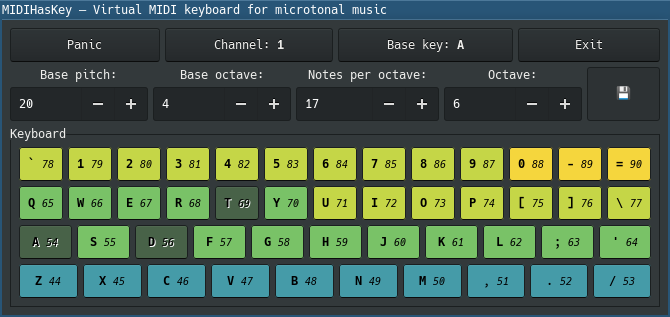Virtual MIDI keyboard for microtonal music.
It works with JACK Audio Connection Kit but technically it can work with anything you name. You’d just have to create an application or a script that handles the events that are coming from MIDIHasKey’s stdout.
One of the main reasons to create MIDIHasKey is to use all keyboard keys efficiently in context of microtonal music. For example Jack Keyboard is trying to simulate the feel of a real piano keyboard by imitating its layout of white and black keys. It doesn’t make any sense for microtonal scales such as 17tet, 19tet, 22tet and many other. Those scales won’t be devided in equal octaves on the piano keyboard, and we have some unused keys,‥ so wasteful when we have just about 2 and half octaves in 12tet scale and even less in other micro scales.
Work in progress! It’s playable but some stuff can be changed or is only partially implemented.
See https://github.com/metachronica/audio-midihaskey/projects/1 page that about progress of first release.
For now you can:
- Play notes by pressing keys on keyboard you set to handle
- Play notes by pressing GUI buttons
- Trigger note-offs for everything by pressing
Panicbutton - Change base pitch, octave, MIDI channel to play to
- Store settings between application restarts
- GNU/Linux
- GTK3
- JACK Audio Connection Kit
For included C++ JACK MIDI Player application. It’s optional (if you have your own app for that) because MIDIHasKey just writes events to stdout (in its own format) and you can redirect it wherever you want.
TODO For me: Document the MIDI Player API. For now you can reverse-engeneer it by looking inside this file for instance. It also will change in the future. - GCC >=6.4.* (maybe lower, but must support C++17)
To build C++ JACK MIDI Player (it’s optional too if you use your own one).
Using Nix
Nix is the recommended way to run it.
You can run it just from a nix-shell:
nix-shell --arg with-midihaskey true --arg with-midiplayer-jack-cpp true --run 'midihaskey /dev/input/by-id/usb-xxxx_yyyy-event-kbd | midiplayer-jack-cpp'Where /dev/input/by-id/usb-xxxx_yyyy-event-kbd is your keyboard device path
(you must have access to read from that file for your current user).
Look at default.nix’s arguments to see available options.
nix-shell -A midiplayer-jack-cppnix-build -A midihaskey.exe -o result-midihaskey
nix-build -A midiplayer-jack-cpp -o result-midiplayer-jack-cpp
result-midihaskey/bin/midihaskey /dev/input/by-id/usb-xxxx_yyyy-event-kbd | result-midiplayer-jack-cpp/bin/midiplayer-jack-cppHere is an example how to build using GHC 9.2.3 (HLS is failing to build at the moment):
nix-build --argstr ghcVersion ghc923 --arg withHLS false -o result-test-ghc923Nix setup for nix-shell includes HLS turned on by default. If you use Vim here is how you can configure vim-lsp plugin to use it:
if executable('haskell-language-server-wrapper')
aug HaskellLsp
au! User lsp_setup cal lsp#register_server({
\ 'name': 'hls',
\ 'cmd': {server_info->['haskell-language-server-wrapper', '--lsp']},
\ 'allowlist': ['haskell'],
\ })
aug END
enSee .envrc example file. See direnv.net if you are not familiar with direnv.
Using Stack
stack build --install-ghc
(cd midiplayer-jack-cpp && make)
stack exec -- midihaskey /dev/input/by-id/usb-xxxx_yyyy-event-kbd | midiplayer-jack-cpp/build/midiplayer-jack-cppViacheslav Lotsmanov
